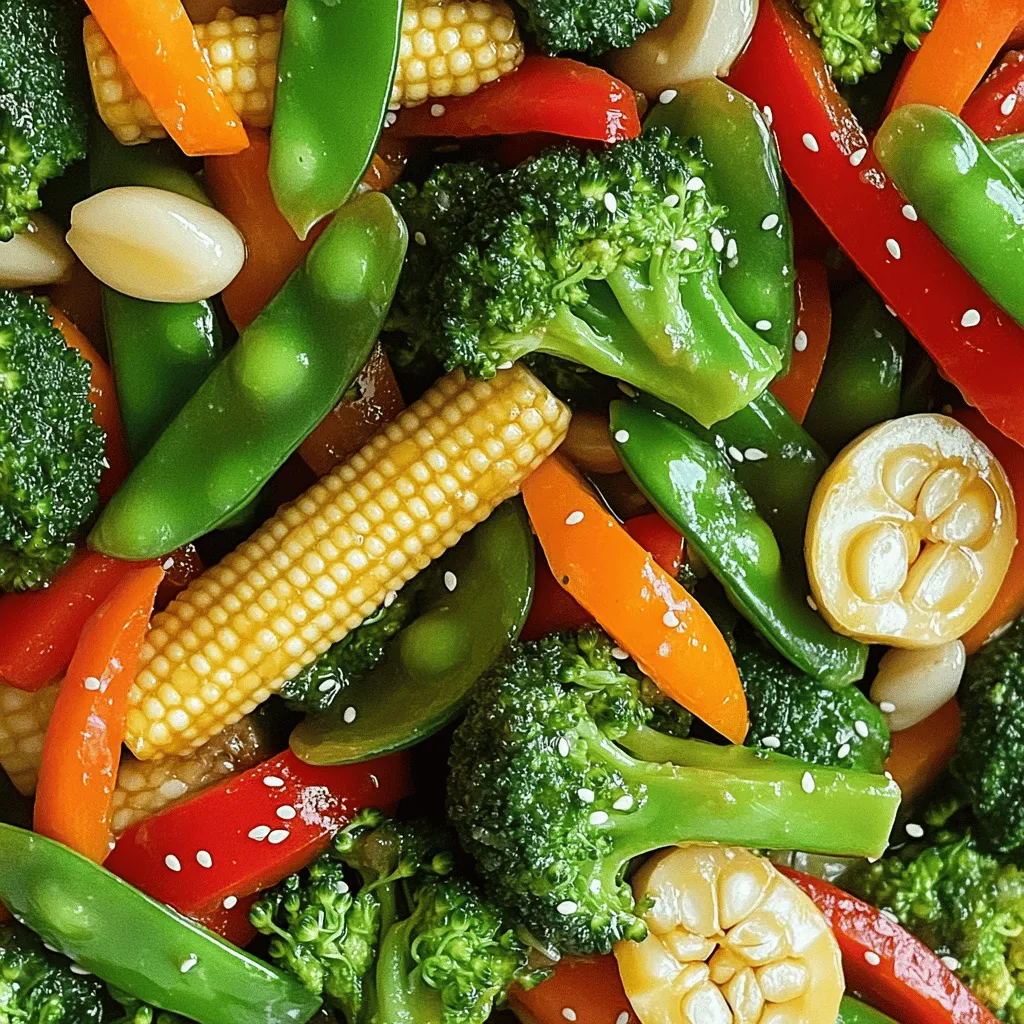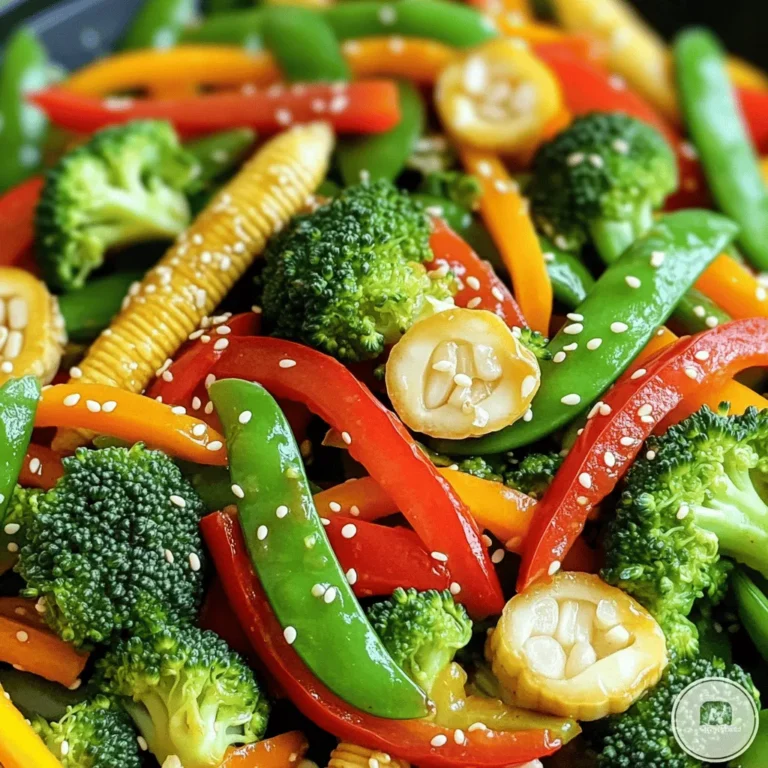Looking for a quick and tasty meal? This Simple Veggie Stir Fry has you covered! With fresh veggies and easy steps, you’ll whip up a colorful dish in no time. Perfect for busy nights, this recipe is packed with flavor and nutrition. Whether you’re a seasoned cook or a beginner, I’ll guide you through each step. Let’s get started on making a delightful stir fry that everyone will love!
Ingredients
Fresh Vegetables Needed
– 1 cup fresh broccoli florets
– 1 vibrant red bell pepper, thinly sliced
– 1 cup crisp snap peas
– 1 medium carrot, cut into julienne strips
– 1 cup baby corn, halved lengthwise
Aromatics and Seasonings
– 3 cloves of garlic, finely minced
– 1 tablespoon fresh ginger, finely grated
– Sea salt and freshly ground black pepper to taste
Essential Liquids
– 3 tablespoons soy sauce
– 1 tablespoon sesame oil
– 1 tablespoon extra virgin olive oil
– 1 tablespoon sesame seeds (optional for garnish)
Gathering these ingredients sets the stage for a quick, colorful meal. Fresh vegetables bring life to the dish. Each vegetable adds its own unique flavor and crunch. The garlic and ginger give a wonderful aroma. They also enhance the taste. Using soy sauce and sesame oil ties everything together. This simple mix brings out the best in your veggies.
Step-by-Step Instructions
Preparation
– Thoroughly wash all vegetables.
– Cut broccoli into bite-sized florets.
– Slice the red bell pepper thinly.
– Julienne the carrot into strips.
– Prepare snap peas and baby corn as directed.
Cooking Process
– Heat olive oil in a skillet or wok over medium-high heat.
– Sauté minced garlic and grated ginger for 30 seconds.
– Add the prepared vegetables and stir-fry for 5-7 minutes.
Final Touches
– Drizzle soy sauce and sesame oil over the vegetables.
– Cook for an additional 2-3 minutes, seasoning to taste.
– Add optional sesame seeds before serving.
This process makes a quick, tasty dish.
Tips & Tricks
How to Enhance Flavor
– Experiment with different sauces or spices.
– Add crushed red pepper for a spicy kick.
To make your veggie stir fry pop, try new sauces. Soy sauce is a classic, but you can also use teriyaki or hoisin. Each adds a unique taste. If you like heat, crushed red pepper flakes bring warmth. Just sprinkle a little in to spice things up.
Achieving Perfect Texture
– Stir-fry quickly over high heat to maintain crispness.
– Avoid overcrowding the pan to ensure even cooking.
For a great texture, cook your veggies fast. High heat keeps them crisp and bright. If the pan is too full, the heat drops. This leads to soggy veggies. Cook in batches if needed. Keep the stir-fry moving to get an even cook.
Serving Suggestions
– Serve over rice, noodles, or quinoa for a complete meal.
– Pair with a protein source like tofu or tempeh if desired.
Serving your stir fry over rice or noodles makes it filling. Quinoa is also a great choice for added protein. If you want more substance, add tofu or tempeh. These options boost protein and flavor. For a fun twist, try serving it in lettuce wraps!

Variations
Seasonal Vegetable Options
You can make your stir fry even better by using seasonal vegetables. Vegetables like zucchini or asparagus add great flavor and texture. These veggies taste fresh and give your dish a unique twist. You can also add leafy greens like spinach. Spinach cooks quickly and boosts the nutrition of your meal.
Dietary Adaptations
If you need a gluten-free option, swap soy sauce for tamari or coconut aminos. These alternatives keep the rich umami flavor without gluten. For some crunch, add nuts or seeds. Almonds or sesame seeds not only add texture but also provide extra nutrients.
Global Inspirations
To give your stir fry a new flair, try adding curry powder for an Indian twist. This spice brings warmth and depth to your dish. Another option is to use teriyaki sauce for a Japanese flavor. It adds a sweet and savory touch that pairs well with your fresh veggies.
Storage Info
Refrigeration Guidelines
To store your veggie stir fry, cool it completely first. This helps keep the food safe and tasty. Next, place it in an airtight container. It can last in the fridge for up to 3 days. When ready to eat, check for freshness before reheating.
Freezing Instructions
You can freeze the stir fry, too! Portion it out into small containers. This way, you can take out just what you need. It will stay good for up to 2 months in the freezer. When you want to eat it, thaw it overnight in the fridge. This keeps the veggies from getting mushy when you reheat.
Reheating Methods
Reheating is easy. You can use a skillet or microwave. For a skillet, heat on low with a splash of water or oil. This keeps the stir fry moist. If you use a microwave, heat it in 30-second bursts until it’s hot throughout. Enjoy the great flavors of your stir fry again!
FAQs
Can I use frozen vegetables for stir fry?
Yes, frozen vegetables can be utilized; add them directly to the hot skillet. I often keep a bag of mixed frozen veggies handy. They save time and still taste great!
How do I keep my stir fry from getting soggy?
Cook over high heat and avoid overcrowding the skillet. This way, the veggies will stay crisp. I always cook in batches if I have a lot of veggies.
What is the best oil for stir frying?
Oils with high smoke points like sesame oil or canola oil are ideal for stir frying. I like using sesame oil for its rich flavor. It adds a nice touch to my stir fry.
This blog post covered how to make a delicious stir-fry with fresh vegetables, aromatics, and essential liquids. Each step is designed for you to create a vibrant dish easily. Remember to keep your stir-fry quick to maintain crispness and flavor. Don’t hesitate to experiment with different veggies and sauces. This way, you can personalize your meal. Lastly, store leftovers properly to enjoy later. You now have the tools to make a tasty, healthy stir-fry that fits your taste!


